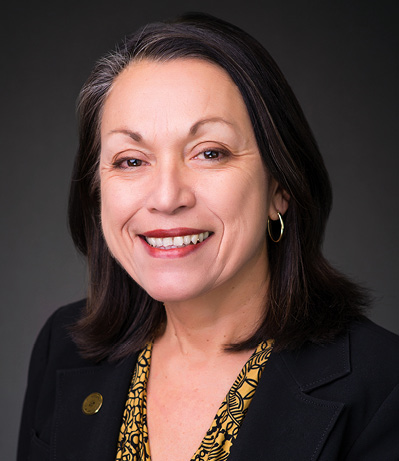

Under educator licensure, we provide licenses to California educators, which is anybody who might be in a school site. It’s not just teachers, but counselors, leaders, school psychologists, school nurses — it’s a range of education professionals that we license. We monitor these assignments. And a big part of our work is to investigate educator misconduct and take appropriate disciplinary action. This area of investigation and disciplinary action is one the public doesn’t see, nor should they, because it is a confidential manner, but I think it is one of the most important requirements and tasks of the commission to keep children and youth safe in our schools.
The third area is reporting. We develop and share different reports on key education issues, including educator supply and credentialing. For example, every April, we get a teacher supply report.
The collective goal is that we want to make sure that this workforce is as diverse as the children that they are serving. And we have an opportunity here, because when you compare early childhood providers with K-12 teachers, this group is more diverse to begin with. There are more Black and brown women, in particular, who make up this workforce.

Educators of color can also serve as what we call cultural ambassadors to help students of color feel more welcome at schools and as role models for students of color. Teachers of color tend to have more positive perceptions of students of color.
It’s also important to emphasize that students of all racial backgrounds can benefit from having a diverse teacher and educator workforce. In some parts of our country, not so much in California, there are no teachers or leaders of color in a school. And so, think about the perceptions that white students may have about leaders of color. When you have educators of color in classrooms, then you have opportunities to talk about race, assumptions about race, class and privilege that are not present in situations where there are not teachers of color.
The most recent teacher supply report looked at the PK-12 student demographics and then compared them with the teaching workforce. While 45 to 50 percent of teachers in California are Latino, a much smaller percentage of teachers are African American, so they don’t reflect the percentage of diversity of our students, but they do reflect the diversity of a workforce overall.
Our job as a commission is to set standards for educator preparation programs that are developing credentials that reflect diversity, equity and inclusion. We provide that vision, that guidance, that expectation, and then it’s our preparation programs that build programs that would result in candidates who have a deep understanding of diversity, equity and inclusion.
That’s a good thing because we’ve long heard from colleagues about some of the negative aspects of RICA including the cost to students. Additionally, there have long been questions about whether this particular assessment truly assessed one’s competency. We assembled a literacy work group a couple of years ago, which included experts who represented the broad areas of interest and expertise related to literacy and reading. The group was facilitated by Nancy Brynelson. We wanted to make sure everybody was “at the table” if you will. In October 2022, the commission approved the literacy standards and TPEs from multiple subjects, single subject and education specialists with moderate support needs and extensive support needs. And finally, the literacy standards and the TPEs for the three low-incidence education specialist credentials will be reviewed at a future meeting.

We know that teacher residency programs tend to attract and retain more diverse candidates. They provide a wage. The residency programs that I am most familiar with are the ones from the CSU, and sometimes the wage was $25,000 a year. Sometimes LEAs were able to braid resources to get that up to $35,000 or $40,000. Other programs were able to work with the district to have their paraprofessionals enroll in these residency programs, which allow them to keep benefits and a salary. It’s a program that has such great promise to recruit and retain.
There is research that says residency programs are the optimal way to prepare teachers because these candidates are at a school site for a whole year and they have these deep learning opportunities that aren’t always available in a traditional student teaching program.
This, to me, has been the greatest gift from the state of California that the commission has been able to provide funding for. Staff also provide technical assistance in helping to develop these programs. Now we have new funding from the Legislature to create a technical assistance center that will be a collaboration between an institute of higher education and an LEA to be a source of technical assistance for developing and current residency programs.
I have had the opportunity to work in a number of educational positions. Several decades ago, I began as a faculty member at CSU Long Beach and the year I was hired, we were going through our accreditation review with the commission. As a new faculty member, I got this indoctrination to what a program review was and I got to see it from that perspective. Then, when I was dean of the college of education, we went through our own accreditation review, which was done jointly with the commission and National Council for Accreditation of Teacher Education (NCATE). I really saw what the commission does from that perspective. I also served on review teams as a faculty member and went to other campuses and helped review programs. Then I came to the commission as the CSU representative.
It’s been interesting to me to see the work of the commission from the different places around the table, if you will. And throughout that time, I continued to be impressed with the work that the commission does — thoughtful, reflective of our three statutory mandates, and caring in a way that I’ve not been a part of in other places that I’ve sat.
I wish the public could see and understand how caring and thoughtful this group of commissioners are and how we put student welfare and student success at the heart of everything that we do. And I mean that very sincerely. The commission staff work so hard behind the scenes in preparation for the meetings to run so smoothly. I also can’t say enough about our executive director, Mary Sandy, who approaches this work with a passion and a thoughtfulness that I think is simply unprecedented.
I know sometimes people aren’t always happy with the decisions or the recommendations that the commission makes, but at the end of the day, I sleep pretty well knowing that the work we’re doing is benefiting the children and youth in California. What’s more important than that?